Imagine that you have been given a gift so wonderful and so magical that you could spend all your days in the pure enjoyment of it … then imagine that your gift brings enjoyment to other people, makes a difference in their lives, gives purpose and pleasure and (in some cases) direction. You love to share your gift and, in sharing, your gift becomes a gift to others.
Now let’s say that your gift is partly a talent – a talent for creating pictures on canvas or paper in oil paints or acrylics or pencil and you spent six years teaching art to high school students at Oak Ridge High School in Orlando, Florida. Your students loved you and when a local defense contractor ran a contest, you entered a rendering of the Space Shuttle that blew away all competition. The company thought so much of your work that they offered you a job doing something you really love to do – creating pictures on canvas or paper with oils or acrylics or pencil.
Now let’s say your gift is also partly a gift of flight which developed into a lifelong love of airplanes and especially antique airplanes and let’s say your name is Richard E. Thompson and you channeled some of your artistic skill into the mysteries of metalwork and woodwork that brought life to eight old airplanes and helped bring to life more than that. On top of an impressive resume of tangible accomplishment in the worlds of art and airplanes, Rick Thompson has a love of history and the love of a patriot for his Country.
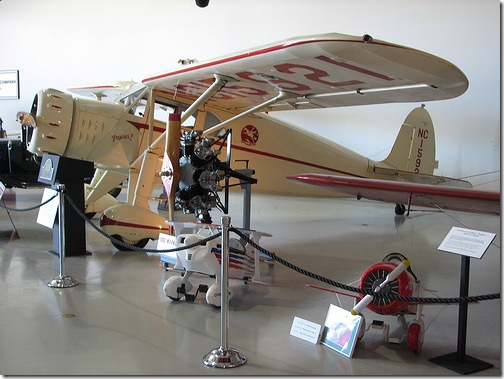
This brings me to Rick’s discovery of a 1934 Fairchild Model 24 C8C in Soldotna, Alaska, where it had been stored as a project since 1995. Alaska is a good place to restore an airplane because it gets real dark and real cold during the long winter months, an ideal environment for a long-term airplane restoration (preferably indoors). There are also a lot of resourceful airplane people in Alaska who know how to make parts and put things back in working order. The Fairchild eventually became an impractical idea as a bush restoration and so in 2008 Rick was able to buy it after 21 years of service, then 53 years as a derelict.
The airplane didn’t look anything like the picture above (of a restored C8C at the Hiller Museum in San Carlos CA) when Rick found it. It was, in that coded parlance of optimists, a “basket case” … bits and pieces collected for the purpose of reassembly but, for Rick and his historian’s sensitivity, the airplane has a story; once owned by a timber company in Idaho and used to keep tabs on the many and various lumber camps that were its domain. One of the airplane’s duties involved the transportation of the payroll to the camps. The workers were paid in gold, so a special compartment was built into the floor of the airplane to carry the payroll – more about this later. A freak windstorm caught the airplane on the ground and flipped it on it back, crushing the rudder, rudder post and doing significant damage to the right wing. It hasn’t flown since 1955. Its journey to Alaska was via one Ed “Skeeter” Carlson of Spokane, WA, who had once flown the airplane and who bought the wreck from the timber company in 1960. Skeeter and the man from Alaska, Frank Hinrikson ... Both very well known and highly skilled in aircraft restoration ... got busy on other projects and did not have time to begin restoration on the C8C. Rick found an opportunity to exercise his talents and skills and so a deal was struck, the parts catalogued, containerized and shipped by sea and train and land to Zellwood, Florida, where it was unloaded, re-catalogued and laid out for further evaluation in preparation for restoration.
Rick doesn’t live all that close to Zellwood and the 60+ mile, hour + drive each way became a drag on the project. Enter friends – always welcome but especially so when it comes to a multi-year commitment to bring life back to an old airplane. Some space was found closer to home, so the Fairchild was loaded on a flatbed truck, parts were gathered and moved to the neighborhood of dreams – Orlando (home of Disney World, Universal Studios, swampland salesmen and alligators, reptilian and human). Dreams are made and discarded minute by minute in this environment but as a Floridian Rick has seen enough of schemes to know which are real and which aren’t. The Fairchild is real and taking shape piece by restored or rebuilt piece.
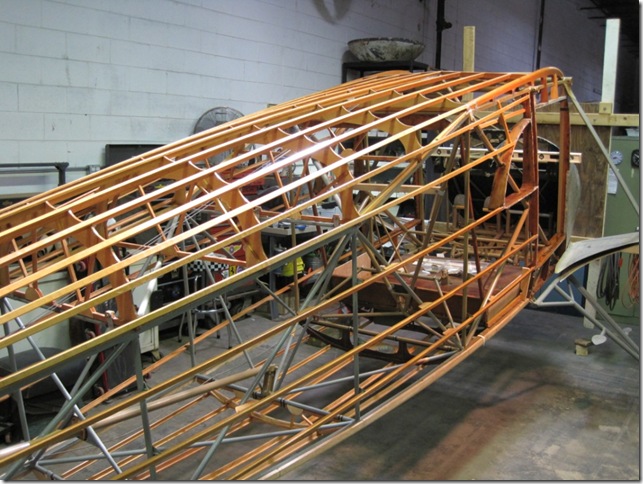
If you are going to rebuild a 1934 Fairchild 24 C8C, you find very quickly there is a LOT of woodwork to be done. It probably helps to meet someone at a family funeral who turns out to be a cousin who also happens to make violins in his spare time! Enter Tim Bandy – cousin, new friend and violinmaker – and you now have a couple of artisans at play.
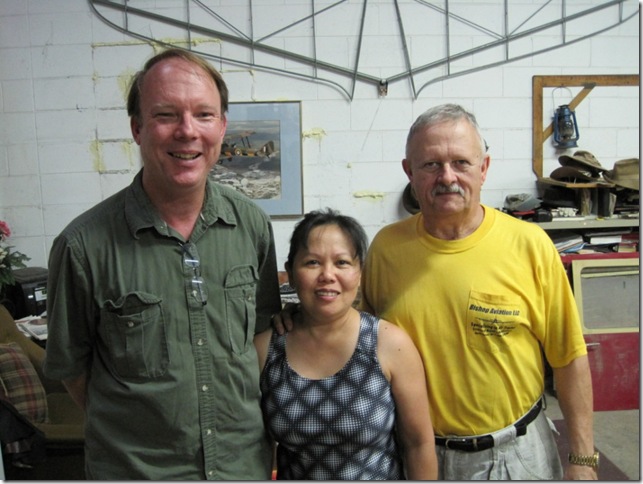
Oh, and while you’re at it, it REALLY HELPS A LOT if you have a wonderful wife and partner - Rose - who happens to have an artist’s hands and skills with needle and thread and fabrics (and who is interested – really interested – in her husband’s aviation affliction). She also makes a great lunch. From left to right, Tim, Rose and Rick take a minute’s break to pose for history. Rick’s sons, Scott and John, were also there when I visited. This is truly a family affair. Adding to the picture, Tim and Rick had heard the same story from their respective sides of the family – that they are distant cousins of none other than Amelia Earhart. Yes friends, this is a real story.
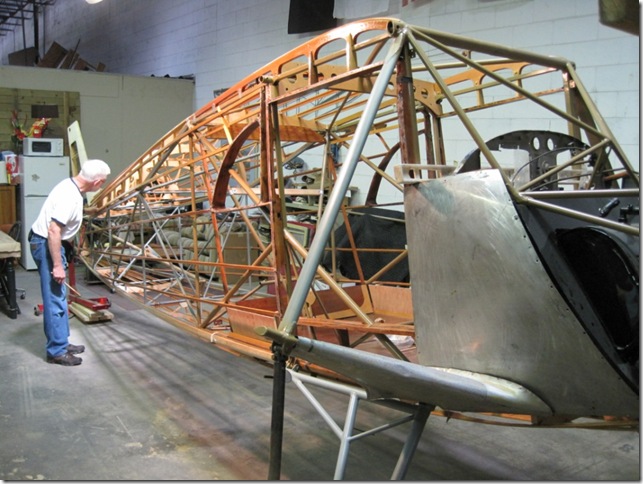 Enter my best friend of over 50 years, David Tooker, shown above inspecting the woodwork, who met Rick when they were teaching at Oak Ridge. David’s father owned the Silver Springs (Fla) Air Park from the fifties to the seventies. I pedaled my ’57 Schwinn six miles to hang around there in the low-raftered building, listening to pilots talk about their wartime and peacetime flying experiences. Every now and then if I hung around long enough, they’d let me get them a beer from the refrigerator or wash their airplanes. David introduced Rick and me at the Sun-n-Fun Fly-In at Lakeland several years ago but it was a glancing blow and it wasn’t until yesterday’s visit that I knew much about Rick. David had been telling me about the Fairchild project but hadn’t seen it for himself. We thought the airplane was still at Zellwood (a PERFECT reason to fly the Bonanza) but as it turned out, the airplane had been moved last year to Orlando, an easy drive for both of us.
Enter my best friend of over 50 years, David Tooker, shown above inspecting the woodwork, who met Rick when they were teaching at Oak Ridge. David’s father owned the Silver Springs (Fla) Air Park from the fifties to the seventies. I pedaled my ’57 Schwinn six miles to hang around there in the low-raftered building, listening to pilots talk about their wartime and peacetime flying experiences. Every now and then if I hung around long enough, they’d let me get them a beer from the refrigerator or wash their airplanes. David introduced Rick and me at the Sun-n-Fun Fly-In at Lakeland several years ago but it was a glancing blow and it wasn’t until yesterday’s visit that I knew much about Rick. David had been telling me about the Fairchild project but hadn’t seen it for himself. We thought the airplane was still at Zellwood (a PERFECT reason to fly the Bonanza) but as it turned out, the airplane had been moved last year to Orlando, an easy drive for both of us.
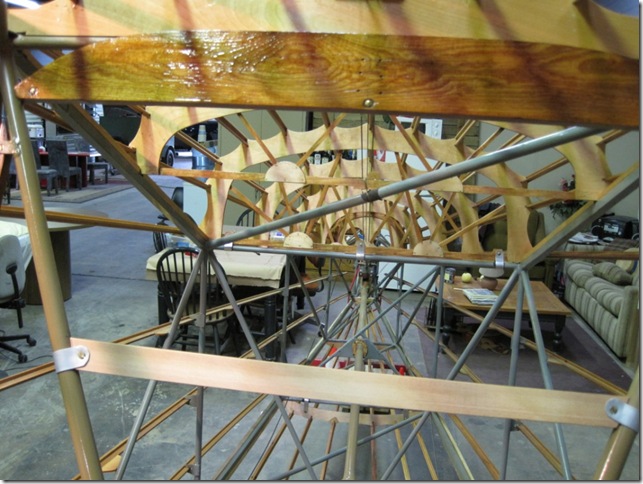 There is a lot of new wood in Rick’s airplane and a fair amount of old wood, considering the age and itinerary of the parts and pieces. Rick strives to keep the airplane as original as possible, so if a part can be reconditioned, it is. The steel tube frame (which Rose glass bead blasted) is finished with 2-part epoxy. Only one small section of lower tubing had to be replaced due to having burst from water freezing – overall, the metal is in remarkably good shape.
There is a lot of new wood in Rick’s airplane and a fair amount of old wood, considering the age and itinerary of the parts and pieces. Rick strives to keep the airplane as original as possible, so if a part can be reconditioned, it is. The steel tube frame (which Rose glass bead blasted) is finished with 2-part epoxy. Only one small section of lower tubing had to be replaced due to having burst from water freezing – overall, the metal is in remarkably good shape.
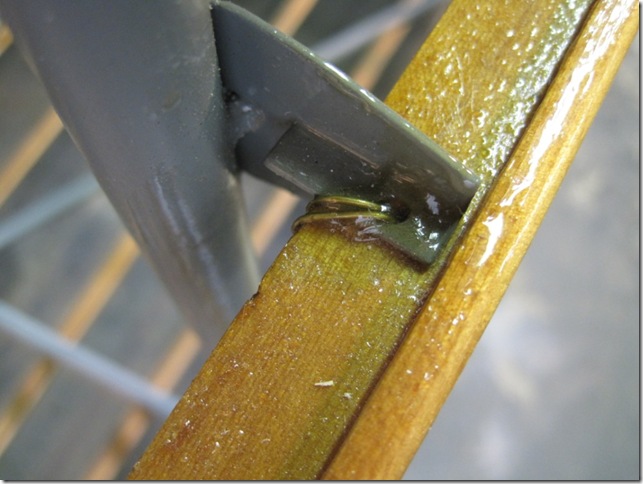 The spruce stringers are finished with 4 coats of 2-part epoxy varnish and provide aerodynamic and aesthetic contour to the slab-sided steel tube frame.
The spruce stringers are finished with 4 coats of 2-part epoxy varnish and provide aerodynamic and aesthetic contour to the slab-sided steel tube frame.
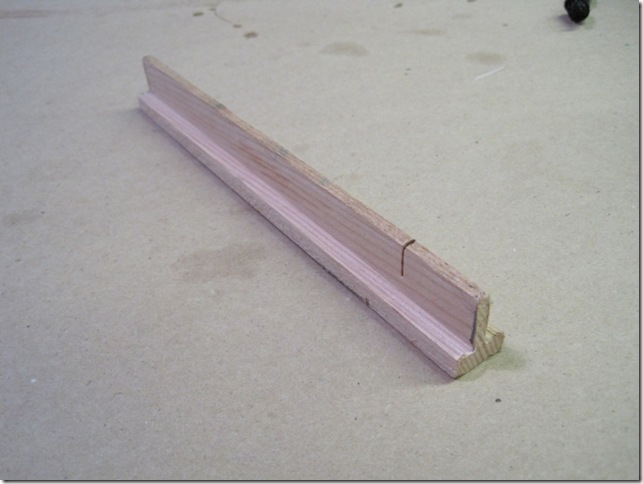
Each stringer was produced in one piece from 1”X 7” X 22’ spruce boards, routed to shape matching the 1934 samples found in the airframe. Each was then catalogued and notes were made about the position of knots or other imperfections so that when a stringer was selected for installation, its eventual position on the airplane was predetermined. Such is the level of intense planning and preparation that goes into Rick’s restoration.
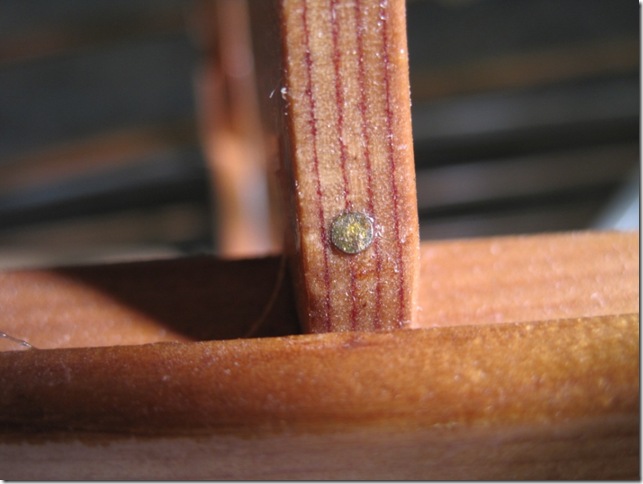
There are a lot of brass nails and straight slotted screws that go into an antique airplane that is largely made of wood!
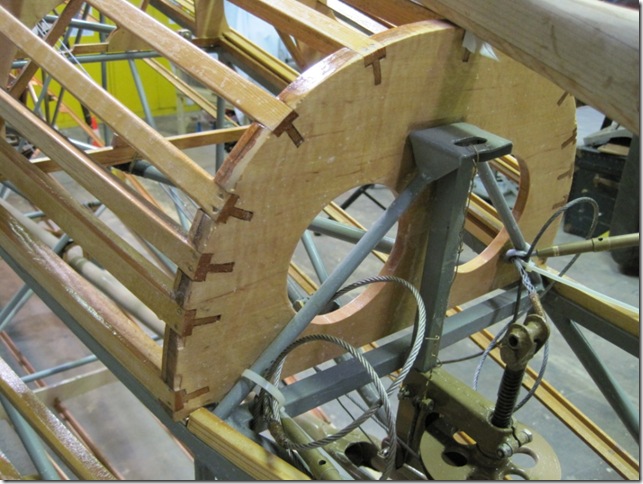
The fore and aft stringer bulkheads are faced with oak to provide additional strength.
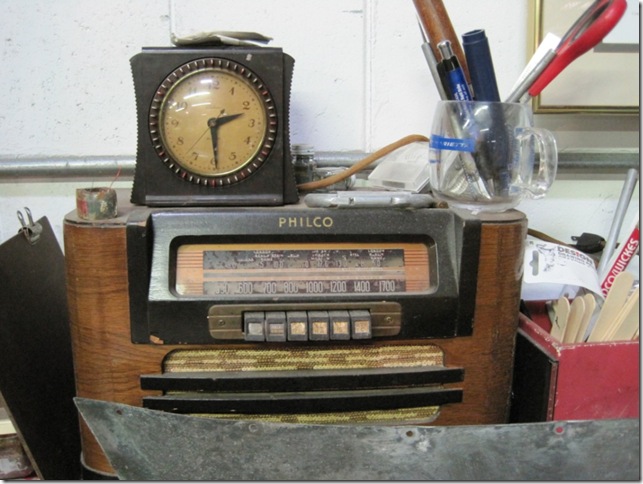
Entertainment is provided by a vintage Philco AM-Shortwave radio. The clock hands didn’t move while I was there – time stood still.
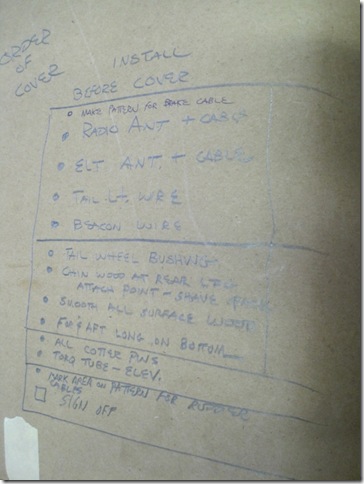
… Rick relies on his quite workable iMac for pictures and handwritten notes on kraft paper.
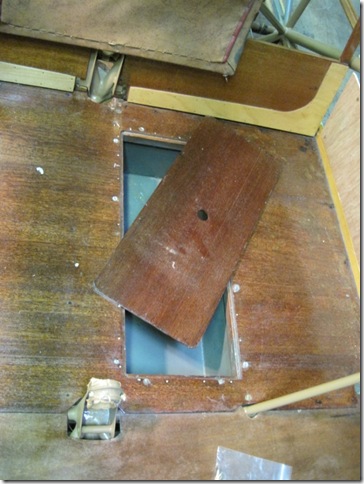
Remember the “gold box” that the timber company built into the floor of the airplane for the payroll? Skeeter asked Rick if he was going to keep the gold box under the 3rd seat and, of course, he did. The early F-24s were originally 3-place airplanes; as is this model. Later models with larger engines were 4-place airplanes.
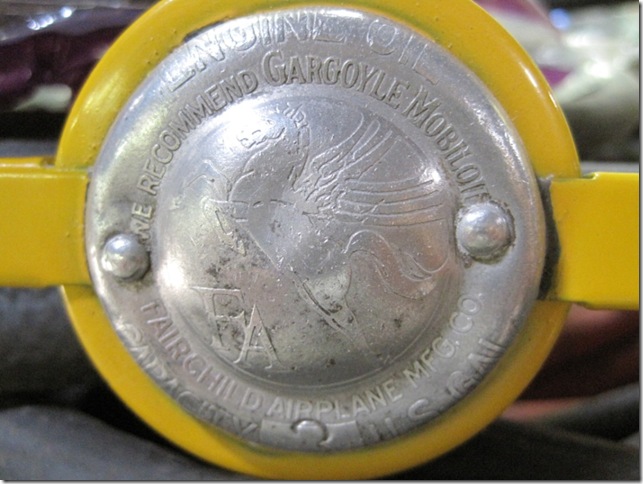
While cleaning the oil tank, Rick found this cap and cleaned it up … all ready for 3 gallons of Gargoyle Mobil Oil to keep the 145 horsepower Warner Super Scarab purring along.
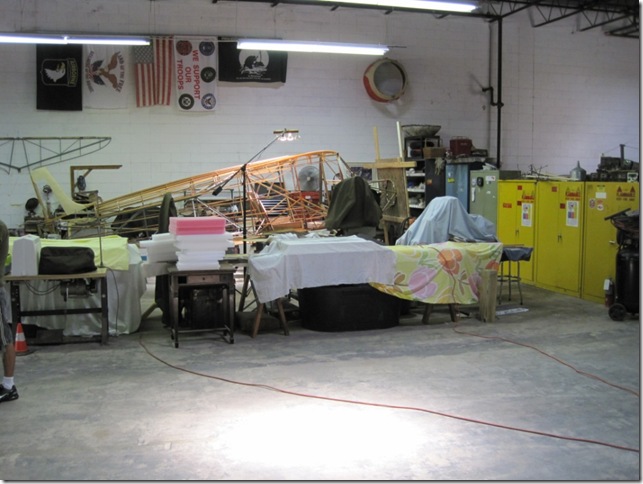
I didn’t want to leave Rick’s corner of the world but David and I had eaten their food and distracted him, Rose, Tim, Scott and John long enough. It was a pleasure to meet them all and to be introduced to “Amelia”, as the Fairchild is to be named.
A few notes of interest:
The first owner of the Fairchild was the father of astronaut and U.S. Senator from Utah, Jake Garn. Jake’s first airplane ride could have easily been in this airplane!
Rick’s other restoration projects included a Ryan PT-22 (winner of “Best Primary Trainer” trophy at the first Sun-n-Fun Fly-In … a North American AT-6 (winner of “Best Trainer” at Sun-n-Fun) , Aeronca Champ and Chief … a DeHavilland Tiger Moth (“Best Primary Trainer” at Sun-n-Fun), a DH 100 Vampire jet, and a highly polished 1946 Cessna 140!
Some of Rick’s paintings can be seen at http://therichardethompsongallery.com/
More on the Fairchild 24 can be found at: http://en.wikipedia.org/wiki/Fairchild_24
Fly safe …
Alex








 Enter my best friend of over 50 years, David Tooker, shown above inspecting the woodwork, who met Rick when they were teaching at Oak Ridge. David’s father owned the Silver Springs (Fla) Air Park from the fifties to the seventies. I pedaled my ’57 Schwinn six miles to hang around there in the low-raftered building, listening to pilots talk about their wartime and peacetime flying experiences. Every now and then if I hung around long enough, they’d let me get them a beer from the refrigerator or wash their airplanes. David introduced Rick and me at the Sun-n-Fun Fly-In at Lakeland several years ago but it was a glancing blow and it wasn’t until yesterday’s visit that I knew much about Rick. David had been telling me about the Fairchild project but hadn’t seen it for himself. We thought the airplane was still at Zellwood (a PERFECT reason to fly the Bonanza) but as it turned out, the airplane had been moved last year to Orlando, an easy drive for both of us.
Enter my best friend of over 50 years, David Tooker, shown above inspecting the woodwork, who met Rick when they were teaching at Oak Ridge. David’s father owned the Silver Springs (Fla) Air Park from the fifties to the seventies. I pedaled my ’57 Schwinn six miles to hang around there in the low-raftered building, listening to pilots talk about their wartime and peacetime flying experiences. Every now and then if I hung around long enough, they’d let me get them a beer from the refrigerator or wash their airplanes. David introduced Rick and me at the Sun-n-Fun Fly-In at Lakeland several years ago but it was a glancing blow and it wasn’t until yesterday’s visit that I knew much about Rick. David had been telling me about the Fairchild project but hadn’t seen it for himself. We thought the airplane was still at Zellwood (a PERFECT reason to fly the Bonanza) but as it turned out, the airplane had been moved last year to Orlando, an easy drive for both of us. There is a lot of new wood in Rick’s airplane and a fair amount of old wood, considering the age and itinerary of the parts and pieces. Rick strives to keep the airplane as original as possible, so if a part can be reconditioned, it is. The steel tube frame (which Rose glass bead blasted) is finished with 2-part epoxy. Only one small section of lower tubing had to be replaced due to having burst from water freezing – overall, the metal is in remarkably good shape.
There is a lot of new wood in Rick’s airplane and a fair amount of old wood, considering the age and itinerary of the parts and pieces. Rick strives to keep the airplane as original as possible, so if a part can be reconditioned, it is. The steel tube frame (which Rose glass bead blasted) is finished with 2-part epoxy. Only one small section of lower tubing had to be replaced due to having burst from water freezing – overall, the metal is in remarkably good shape. The spruce stringers are finished with 4 coats of 2-part epoxy varnish and provide aerodynamic and aesthetic contour to the slab-sided steel tube frame.
The spruce stringers are finished with 4 coats of 2-part epoxy varnish and provide aerodynamic and aesthetic contour to the slab-sided steel tube frame.








